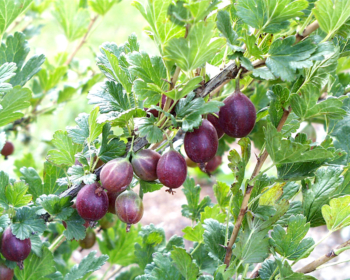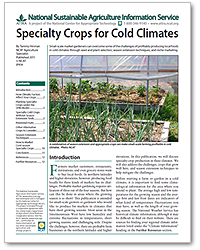Specialty Crops for Cold Climates

A combination of season extension and appropriate crops can make small-scale farming profitable in cold climates. Photo: NCAT
By Tammy Hinman, NCAT Agriculture Specialist
Abstract
Small-scale market gardeners can overcome some of the challenges of profitably producing local foods in cold climates through seed and plant selection, season extension techniques, and niche marketing.
Contents
Introduction
How Climatic Factors Affect Your Crops
Planting Specialty Crops under the SPIN Model
Specialty Cold Crops Without Season Extension Tools
Perennial Fruits
Other Alternative Crops to Consider
Season Extension Techniques
How to Market Cool-season Specialty Crops
Conclusion
References
Further Resources
Introduction
Farmers market customers, restaurants, institutions, and even grocery stores want to buy local foods. In northern latitudes and higher elevations, however, producing food locally for these kinds of markets has its challenges. Profitable market gardening requires utilization of three out of the four seasons. But how can this be done in areas where the growing season is so short? This publication is intended for small-scale growers or gardeners who would like to produce for markets in climates that have short growing seasons. Most areas in the Intermountain West have low humidity and extreme fluctuations in temperatures, short growing seasons and challenging soils. Despite the challenges, however, there are profitable farm businesses in the northern latitudes and higher elevations. In this publication, we will discuss specialty crop production in these climates. We will also address the challenges, crops that grow well here, and season extension techniques to help mitigate the challenges.
Are you a cold climate farmer?
The United States Department of Agriculture has designated specific “zones” throughout the United States based on average first- and last-frost-free dates and minimum and maximum temperatures. The USDA Hardiness Zone Map divides North America into 11 separate zones; each zone is 10°F warmer (or colder) in an average winter than the adjacent zone (US National Arboretum, 2011). If you see a hardiness zone mentioned in a catalog or plant description, chances are it refers to the USDA map. This map provides a rough estimate of what types of crops, trees, and shrubs can grow in your area. This publication will use a reference point of Zone 5a or lower to define cold-climate farming. To find your zone see the Plant Hardiness Zone Map from the U.S. National Arboretum website.
Before starting a farm or garden in a cold climate, it is important to find some climatological information for the area where you intend to plant. The average high and low temperatures for the growing season and the average first and last frost dates are indicators of what kind of temperature fluctuations you may have, as well as the length of your growing season. The National Weather Service has historical climate information, although it may be difficult to find on their website. There are sources for finding your regional climate information listed under the “Climate Information” heading in the Further Resources section.
How Climatic Factors Affect Your Crops
Temperature Fluctuations
Many vegetable crops, especially warm-season crops such as tomatoes, peppers, and eggplants, do not grow well with the wide temperature fluctuations that are common in the Intermountain West. In many areas of the temperate Intermountain West, the lack of relative humidity in the air will cause day and nighttime temperatures to differ by 50 degrees in the summer months. This is not the case in northern latitudes of the Midwest and Northeast, where temperatures typically stay 20 degrees warmer at night. In order to grow sensitive warm-season crops, efforts to moderate temperature fluctuations must be made, or you need to account for cold night temperatures by adding two weeks to the “days until maturity” listed in your seed catalog or packet (Gough, 2008). Simple hoop houses and low tunnels are quite effective at moderating cool nighttime temperatures. For more detail on this topic see the Season Extension section in this publication.
Temperature fluctuations can be challenging for cool-loving crops as well, but for the opposite reason: high daytime temperatures are stressful. Shade structures and shade cloth can help extend the growing season for heat-sensitive crops such as spinach, mustard greens, and lettuce. It is also essential to plant successions of these crops in order to guarantee full supply of these products, but shade will help insure that specific plantings will last longer. For more information on succession planting see the ATTRA publication Scheduling Vegetable Plantings for Continuous Harvest.
Limited Frost-free Days
Another feature of colder climates is a limited number of frost-free days. It is not uncommon for the average last frost date to be in late May/ early June and the average first frost date to be in mid-September. A number of crops actually do well with light frost and cooler temperatures that tend to dominate the early and later parts of a growing season in cold climates. These crops are often referred to as cool-season crops. They include a host of Brassicaceae (broccoli, mustards, kale, etc), lettuces, onions and peas. For a list of common cool and warm-season crops see Tables 1 and 2.
| Table 1: Cool-season Crops that Do Not Require Protection | ||
| Crop |
Number of successions |
Intervals between plantings |
| Peas |
1-2 |
Spring and late summer for fall harvest |
| Radishes |
4 |
Every 2 weeks in spring and fall |
| Mustard Greens (including arugula) |
3 |
Every 2 weeks in spring and fall |
| Broccoli |
2 |
Spring and late summer for fall harvest |
| Cauliflower |
2 |
Spring and late summer for fall harvest |
| Lettuce |
4 |
Every 2 – 3 weeks |
| Fennel |
2 |
Spring and late summer for fall harvest |
| Radicchio |
3 |
Every 2 weeks in spring and fall |
|
Scallions |
4 |
Every 2-3 weeks |
| Table 2: Warm-season Crops that require protection if planting before average last frost date | ||
| Crop | Number of successions | Intervals between plantings |
| Tomatoes * | 1 | From transplant |
| Peppers * | 1 | From transplant |
| Eggplant * | 1 | From transplant |
| Summer Squash | 2 | From transplant and direct seed once |
| Winter Squash | 1 | From transplant |
| Beans | 3 | Every two weeks |
| Basil | 3 | Every 3 weeks |
| Melons * | 1 | From transplant |
| * These plants will be more likely to yield fruit if they are under a crop protective cover for the entire season in Zone 4 or lower. | ||
Planting Specialty Crops under the SPIN Model
SPIN is an acronym for Small Plot Intensive farming. SPIN farming is a non-technical, easy-to-learn and inexpensive-to-implement vegetable farming system that makes it possible to earn significant income from land bases under an acre in size. Founded by a couple in Canada, SPIN utilizes extensive succession planting (called relays) of profitable crops that require little space to produce. Many of the crops utilized within the SPIN model happen to be cool-season crops such as radishes, scallions, lettuce mix, and greens mixes. SPIN farming mostly takes place in urban areas where local food marketing opportunities are plentiful, and land is not. For more information on the SPIN-farming production model see the Further Resources section below.
Specialty Cold Crops Without Season Extension Tools
Specialty Vegetables
Specialty vegetables can be considered any variation from the typical market fare. This could be baby, heirloom, or ethnic products. Producing specialty vegetables is a way to set yourself apart in local markets and often command a higher price. Many upscale restaurants are also very interested in unusual and gourmet fruits and vegetables and are willing to pay a good price for these products.
Ethnic Vegetables
Ethnic vegetables are a way to set yourself apart at farmers markets, but it is important to research a market beforehand. What ethnic populations shop there? If you are already selling at a farmers market, ask your ethnic customers what kind of vegetable they would like for you to produce. Many specialty ethnic vegetables happen to be warm-season crops, such as chili peppers, bitter melons, and eggplants; however, there are a host of Asian greens, ethnic herbs, and Italian vegetables that grow well without season extension tools in cold climates.
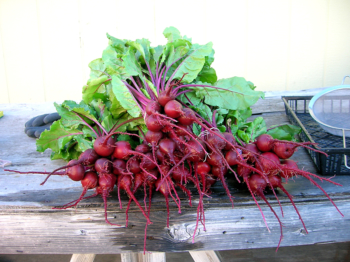
For root vegetables such as baby beets, “golf ball size” is a standard measurement for when to harvest.
Photo: NCAT
Baby Vegetables
The baby vegetable craze began in Europe about 15 years ago. Many high-end restaurants in the United States have adopted the trend and look to local farmers to supply them. Baby vegetables are also very popular at higher-end farmers markets. The critical production strategy with baby vegetables is succession planting and timing of harvest.
For lettuce and greens, you can use your hand as a measurement tool. A common measurement is to harvest baby lettuce greens smaller than your hand. Plant your produce every 2-3 weeks to insure that the products stay young and succulent and the optimum size for harvest. For more information see the ATTRA publication Scheduling Vegetable Plantings for Continuous Harvest.
A Word about Seed
Judy Fisher in one of her garden seed plots. Photo: NCAT
Using seed and planting stock that is well adapted to cold climates is important for successful gardening. For warm-season crops such as melons, tomatoes, peppers and eggplants, look for seed that has “short days to maturity.” A typical seed package will include the “days to maturity” on the back. If you are ordering from a catalog, look for warm-season crop seeds that mature in less than 75 – 80 days. I always recommend using seed that is adapted to your region, which may be available from small, regional seed companies. Judy Fisher, the owner/operator of Fisher Garden seeds, a third-generation, small, family-owned seed business in Montana, has maintained many varieties that were developed by her uncle, Ken Fisher. These are adapted to high elevation and cold climates. Her warm-season crop varieties are selected for short days to maturity, and tolerance for cool nights. She also grows and selects seed for a host of cool-season crops and flowers. As one example, her Mountaineer winter squash seed is well adapted to the cool nights and short growing season in Montana. It produces loads of flavorful orange-fleshed winter squash that keeps well through the winter. For more information and to order a catalog, see the Further Resources section.
Perennial Fruits
Many fruit trees do not produce in the northern part of the Intermountain West because they blossom before the last average frost-free day, or because the tree itself can’t tolerate deep cold snaps during winter. Some fruit trees are adapted to Zone 4 or lower, however. When purchasing fruit trees we recommend buying from a local nursery that carries hardy stock. Also, look for root stock that is adapted to cold climates. There are specialty fruit shrubs and vines that do well in colder climates, including brambles, strawberries, and gooseberries. Also, many perennial and biennial fruits can be grown in hoop houses to extend the growing season both earlier and later.
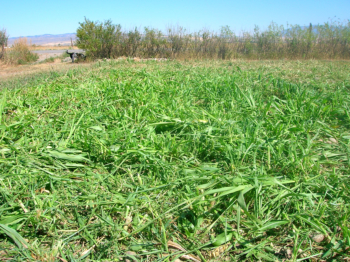
Weed-eaten sorghum-sudan grass at the author’s farm. Photo: NCAT
In perennial fruit plantings it is difficult to manage weeds once the plants are established, so it is important to start with as clean a bed as possible. Cover crops are a great way to prevent weeds initially, with the added bonus of increasing organic matter in your beds. One strategy is to let some weeds germinate in the spring, then till them in. Follow this with an aggressive summer cover crop, such as sorghum-sudan grass or buckwheat. These are warm-season cover crops, so they need to be planted after your last frost date. The seed germinates best when soil temperatures are high: June – July is ideal. Once the summer cover crop is 3-4 feet high (or, with buckwheat, when it is in full bloom) mow (or weed eat on a smaller scale) and incorporate in late summer/ early fall (mid-August). The cover crop can be incorporated with a rototiller, or whatever primary tillage implement is available. Follow up with an oat/pea cover crop (in early September) that will winter-kill in most cold climates. This crop residue can be incorporated easily in early spring for spring fruit planting.
The New York State Agriculture Experiment Station has developed an online guide for cover crops. It details planting, maintenance and incorporation information for many types of cover crops suitable in the Northeast and northern cold climates. The information and link for this publication are in the Further Resources section below.
Fruit trees and bushes are best planted dormant in early spring or mid fall. The following section will focus on specific perennial fruits that thrive in colder climates.
For more specific production information for these particular fruits, see the following ATTRA publications:
Brambles: Organic Production
Strawberries: Organic Production
Brambles
Brambles are a hardy perennial fruit. They typically like acidic soils, but are tolerant of a wide range of soils. They have potential for high sales, especially early in the season, before production begins in people’s home gardens. Producing brambles and strawberries in hoop houses is a way to increase the season for two to three weeks on either side of field production. Hoop houses can also help prevent certain pests that can be devastating to brambles, such as cane borers.
Hoch Orchard, an organic orchard in Minnesota, has two Haygrove field tunnels with bramble crops inter-planted with annual and long- term perennial fruits. The short-term crops within the tunnels are annual vegetables and strawberries. Mid-term perennial fruit crops such as raspberries and blackberries are planted every other row. Long-term perennial sweet cherries that are not able to grow outside in their northern climate are planted in the tunnels. As plantings mature, the owners are able to generate revenue from the strawberries and brambles within the tunnels for the first, second and third years, before the cherries mature. Their hoop-house brambles are available both before and after their field-grown brambles.
Cornell University Department of Horticulture has developed the prototype for hoop house bramble production. Their guide offers detailed production information, including plant selection, high tunnel construction, and care and management of established plantings. High Tunnel Production Guide for Raspberries & Blackberries is available online as a PDF document.
Although the Cornell publication is an excellent resource for producing raspberries in hoop houses, it does not focus on organic production. See ATTRA’s publication Brambles: Organic Production for specific information on organic pest and fertility management.
Alternative Fruits
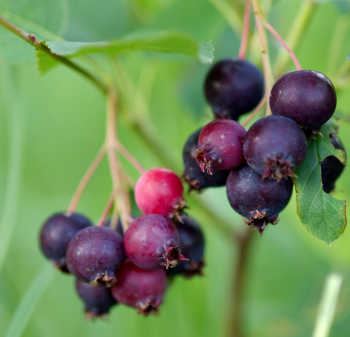
Serviceberry. Photo: dbarronoss, Creative Commons
Amelanchier or June Berries
Amelanchier alnifolia, a sturdy Montana native shrub, produces blueberry-like fruit that’s sweet and juicy. This shrub, which is grown mainly as a landscape plant in cold climates, is known by many names including Saskatoon, serviceberry, and Juneberry. It is a good choice for cold-climate production, particularly in the Intermountain West. The plants prefer rich, moist, well-drained, slightly acidic soil, but they are adaptable to many soil and climate conditions. They can thrive in full sun or partial shade, wet or dry sites, and some species even tolerate drought. Good soil, drainage, and air circulation will prevent any leaf diseases, and watering during droughts will reduce stress and optimize fruit yields (Gough, 2010).
Amelanchier is often compared to the blueberry in terms of the berry’s size, texture and flavor, with more of an almond flavor and distinctive seeds within the berry. The bushes produce clusters of flavorful sweet fruit. Saskatoons grow in a bush format and—once mature—can range in height from 6 to 14 feet and approximately 4 to 6 feet in width.
‘Regent’ is the variety grown for its fruit, but there are many other cultivated varieties. Relatively small orchards or plantations of species that have been selected for their fruit may produce high yields and profits, especially in areas where blueberries do not grow. For more information on production, planting, and where to find stock, see the Further Resources section below.
Gooseberry and Currant
Gooseberries and currants are closely related (both are Ribes spp. ) and have relatively the same management requirements. Currants have three different distinct types—black, red, and white— while gooseberries range from greenish-white to red. While they will tolerate a wide range of soils, a well-drained soil high in organic matter will bring the highest yields.
Plant gooseberries 4 to 5 feet apart. Currants and gooseberries have relatively little pest pressure. White pine blister rust used to be a big problem with Ribes species, but there are resistant varieties available now (see the text box for resistant varieties). Mature plants will yield 4 to 5 pounds of fruit per bush. Gooseberries have thorns and this should be a consideration in harvesting fruit.
This variety is a hybrid named Jeanne. It is a late-ripening, dark red, dessert gooseberry. Photo: Kim Hummer, courtesy of USDA, ARS National Clonal Germplasm Repository Corvallis
Gooseberry Varieties
There are several thousand varieties of gooseberries; 3004 red, 675 yellow, 925 green, 280 white. In general, gooseberry varieties fall into two categories: the small-fruited but mildew resistant American gooseberry (Ribes hirtellum) and the larger European gooseberry (Ribes uva-crispa); however, most varieties in the US are hybrids of the above two species, one American and one European.
Some Gooseberry Varieties resistant to WPBR (white pine blister rust):
Hinnomaki Red is a dark red medium-sized fruit from Finland, with an outstanding flavor, whose outer skin is tangy, while the flesh is sweet.
Amish Red is a new large-fruited and flavorful variety with excellent disease resistance.
Poorman originated in Utah, the result of an American X European type cross, and was introduced in 1888. Don’t let the name fool you, as it is one of the larger, better-flavored, fresh-eating type of gooseberry, equally good for pies, jams and other processed products (Moorely 1999).
Other Alternative Fruit Crops with Economic Potential
There are many cold-hardy fruit shrubs that have some economic potential for specialty fruit growers in cold climates but are not regularly used for commercial purposes. Lingonberry is a very cold-hardy shrub native to Scandinavian highlands. It has a tart flavor similar to cranberries. They require a low pH (or acid) soil, so it would be difficult to grow them in the Calciferous soils of the arid west. Highbush cranberries are more tolerant of different kinds of soil, except clay. Their berries are tart and firm and they sweeten and soften after frost. Some varieties grown for their fruit include ‘Andrews’ and ‘Wentworth.’ (Nelson, 2003). The Arctic, or hardy, kiwi has smoother skin than the typical kiwi you see in stores. It also has potential as a cash crop, but it needs a protected spot if you are producing in Zone 4. It will likely not survive in Zone 3 or lower.
Other Alternative Crops to Consider
Hops
Hops are a cold-hardy plant with renewed market potential from the popularity of micro-brewing. Hops are very hardy perennial vines that require a trellising system. Currently, most hops are grown on the Pacific Coast, where disease pressure is less than in the humid eastern U.S.

The most significant investment for hops production is the trellising system. Photo: NCAT
Hops are produced on climbing vines from female rhizomes planted one to a hill, with four to six vines per plant. The female cone is the part of the hops plant that is marketable. The cone is only produced on plants that have a trellising system. Vines are trained on almost vertical strings to a flat overhead trellis. Trellis pole supports need to be at least 12 feet above the ground and no more than 25 feet apart.
Building a small-scale commercial hops trellis is a huge undertaking. Even a small project requires a lot of planning, good communication skills, management of time and financial details. A North Central SARE grant funded research on hops market development at Simple Earth Hops farm. Their website has a lot of information on establishing a ¼-acre hopyard measuring around 100′ x 100′. See the Further
Resources section for the link to this presentation and other information on growing and marketing hops.
Herbs
The ATTRA publication Herbs: Organic Greenhouse Production specifically address production of herb crops.
Many perennial herbs are cold-hardy and work well within a diversified farming operation. Cold-hardy culinary herbs include thyme, sage, oregano, and mint. Some medicinal herbs are also very hardy in cold climates, such as echinacea, wormwood, motherwort, pennyroyal, scullcap, valerian, catnip, and licorice.
Culinary herbs are fairly easy to grow, and most make it through harsh Zone 3 to 4 winters. Mulching herbs with straw, shredded bark, or leaves will help ensure their winter survival. Some of the medicinal herbs are also quite hardy, but others take some horticultural finesse to simulate their natural environment. When ordering seeds or starts, it is important to follow the directions for cultivation and site choice. A resource list for information on growing and marketing medicinal herbs is available from the Alternative Farming Systems Information Center (a section of the National Agriculture Library).
Season Extension Techniques
Hoop Houses
Hoop houses, or high tunnels, are simple unheated greenhouse-like structures that provide less control of environmental conditions than full greenhouses, at substantially less cost. They are usually covered with a single layer of plastic and are ventilated only with roll-up sides. A typical high tunnel does not have a heating or cooling system and is easily taken down and put up. In most areas this is an advantage because it does not have a foundation and is considered a “non-taxable” structure.
The hoops for the high tunnel are often placed approximately 4 feet apart. Many plans call for using 2-inch schedule 40 PVC for the hoops, which is an economical alternative, but the plastic pipes tend to be less rigid than metal and more susceptible to damage in areas of high winds. A narrow building width (approximately 14 feet or so) lends itself well to roll-up-side ventilation. Tunnels and greenhouses with vertical sides that rise up before curving provide better side-to-side ventilation and allow for better use of growing spaces along the edges inside than an arc frame. In order to have vertical sides, however, you must use fabricated pipe, or bend the pipe yourself (Blomgren and Frisch, 2007).
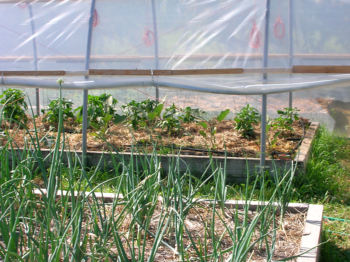
The author’s small 20-foot x 12-foot hoop house built over an existing raised bed. The hoop house is taken down in the winter and rotated to different bed each
year. Photo: NCAT
Drip irrigation is often used in high tunnels. It works well because it keeps relative humidity down, which helps prevent diseases. Another disadvantage of overhead irrigation is that it can burn the leaves if it is done in the middle of the day. A typical production system for high tunnels is in-ground culture, but alternatively pots can be placed on the ground or on benches.
An excellent USDA-sponsored project that has tested and promoted high tunnel systems in the Central Great Plains is hightunnels.org. This online resource features three different plans on how to build simple hoop houses, as well as cultural information on growing certain vegetables and fruits in them. It is one of the best comprehensive, and farmer-friendly resources about hoop houses on the Internet.
When considering a hoop house structure, it is important to calculate the costs and returns of building one. Hoop houses are commonly sold in units of 48 or 98 feet long, but they can be ordered in any length. The cost of a 14’ x 96’ unit of single poly, with roll-up sides and including end-walls and doors and drip tape is about $2000-$3000, depending on the construction materials (Conner, 2007).
Michigan State University Horticulture program has developed a sample business plan with enterprise budget samples for cool- and warm-season crops based on costs and returns from several different farms.
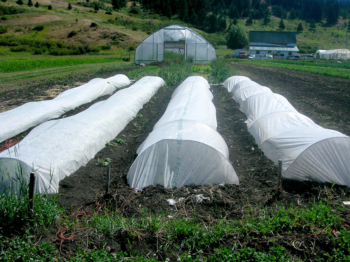
Gallatin Valley Botanicals farm in Bozeman, Montana, utilizes both low and high tunnels as season extension tools. Photo: NCAT
Low Tunnels
Low tunnels are a “mini” version of the hoop houses described above. They are used as temporary season extenders and work well to keep nighttime temperature up to 5 to 10 degrees higher than ambient air temperature. Electrical conduit that measures 1 to 1½ inches works well to form hoops. At our farm, we have 3-foot beds and use 6-foot long, 1-inch electrical conduit. If the conduit is longer (approximately 10 feet works best), hoops can be driven 1 foot into the ground to secure them on either side of the bed. We placed our hoops about 2½ to 3 feet apart. Another option is driving 2-foot rebar lengths or a larger-diameter conduit on either side of the bed to hold the hoops upright. If you are in an area of high winds, the hoops can be further secured with twine. We secured 10-foot-wide plastic from an old greenhouse on one side by digging a trench, placing 6-8 inches of plastic in it, and filling it over. The other side has heavy-duty plastic sandbags filled with rocks. This design has withstood the 30-40 mph winds we get at our place. There are a few different designs available.
Well-known season extension pioneer Eliot Coleman uses his low tunnels to grow cold-hardy vegetables through the winter and to overwinter some crops to be made available first thing in the Spring. We reserve our low tunnel for growing warm-season crops that take a lot of room, such as melons and cantaloupes.
Plastic Mulch
Many growers use black plastic mulch over their beds to increase soil warmth in the spring. The potential benefits of using plastic mulch include soil warming, reduced evaporation, increased yield and earliness, reduced nutrient leaching, improved nutrient uptake, and weed management (Grubinger, 2004). Of course, there are downsides, too. These include the cost of the material and greater labor and equipment expense to apply and remove the mulch. Disposal fees can be significant, as well.
There are many different colors of plastic mulch. The color of mulch has a big influence on how it affects the microclimate around a crop plant. There has been extensive research on different-colored mulches and their efficacy, much of which has been done at the Penn State Center for Plasticulture. Their website is quite informative regarding their research on different-colored mulches http://plasticulture.cas.psu.edu/.
Most growers generally buy black plastic mulch, however. It is often used in combination with some of the season extension strategies described above. If you are certified organic, or plan to become certified, it is important to keep in mind the organic standard for using plastic mulch:
§ 205.206 (c) (6) Crop pest, weed and disease management practice standard:
“Weed problems may be controlled through plastic or other synthetic mulches, provided that they are removed from the field at the end of the growing or harvest season.”
How to Market Cool-season Specialty Crops
For any market garden, it is important to consider which market is right for you and your farm. In order to assess the types of markets it is important to ask yourself these questions:
Is my farm location conducive to direct marketing?
Are you near lucrative farmers markets, restaurants, and specialty food stores? If not, you might need to consider wholesale marketing.
Do I enjoy interacting with people?
If so, farmers markets might be perfect. If not, something that does not require as much personal interaction might be a better fit.
Many of the crops described here are unique and could provide a great draw to a farmers market stand throughout the season. If you are using these season extension techniques on your farm, chances are that your harvest season extends past the season of operation for a typical farmers market or other seasonal direct market. This section will describe some options for marketing specialty vegetables and fruits beyond the typical farmers market.
Winter Farmers Markets
The farmers market season is extending in many locations across the U.S., with year-round markets, special winter or holiday markets, or simply a longer season that runs through December. It is important to decide to produce for these markets by late summer/ early fall. The crops that you would like to market in late fall need to be planted in the field or hoop house in late July or early August in order to achieve optimum yields in the limited light and cold days of winter. If you currently sell at a farmers market, ask the market coordinator if they would consider extending the market into the winter months.
Restaurants
Related ATTRA Publications:
Tips for Selling to Restaurants
Selling to Local and Regional Markets: Barriers and Opportunities for Beginning Farmers
Many restaurants are interested in local foods, and will pay a premium. They can be a lucrative market, especially if you are located in an area with several high-end restaurants. In order to receive a price premium for your product there are a few general guidelines. Make a personal visit to the chef, and bring a sample of one of your products—something that sets you apart. Make sure that your product is clean, you are clean, and that you visit when they are not busy—at an off-time during restaurant hours. It is generally good to avoid the hours during lunch and dinner and it is always a good idea to call the executive chef first.
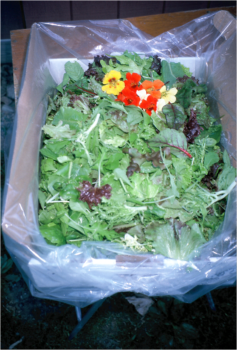
A clean, professionally packaged sample goes a long way with restaurant sales. Photo: Krista Stosiek, Markristo Farms
Chefs appreciate knowing what is available every week. They also appreciate knowing what is in season. Faxing or emailing a weekly availability list that includes prices will remind chefs that you have product available to sell. When you deliver, put on clean clothes and make sure your delivery boxes are clean and presentable.
Gourmet and Specialty Food Markets
Gourmet and specialty food markets will appreciate local specialty vegetables and fruits such as the ones described above. It is important with some of the fruits, especially the wild fruit varieties, to know the shelf life on these products and have an understanding of the post-harvest handling techniques required to keep them fresh.
These types of markets may have food safety requirements that are more stringent than farmers markets, such as a GAPs (Good Agricultural Practices) plan. They also may have standardized packing requirements that are foreign to many small growers. When approaching a specialty store, contact the produce buyer, and ask what type of products they are interested in and what their packing and food safety standards are. For more information on GAPs see the ATTRA publication Illustrated Guide to Growing Safe Produce on Your Farm: Good Agricultural Practices.
Conclusion
Specialty crop production in cold climates is possible using seeds and plants that are adapted to your region and season extension techniques. Researching historical climate and soil data for your region will help you gain an understanding of the types of crops you may be able to grow successfully, or when and with what crops to use season extension tools.
Season extension techniques such as hoop houses, low tunnels, and plastic mulch can aid the cold-climate grower by boosting nighttime temperatures and providing protection from frost early and late in the season.
There is potential for finding lucrative markets for alternative and specialty crops in cold climates. It is important to assess the markets in the area as well as your own propensity for direct marketing as a part of the farm planning process.
References
Blomgren, T. and T. Frisch. 2007. High Tunnel Production. University of Vermont. 77 p.
Conner, D. 2010. Model business Plan with Hoop house for Season Extension .Michigan State University. Extension Bulletin 3112. 28 p.
Gough, Robert. 2010. Juneberries for Montana Gardens. Montana State University Extension. 2 p.
Gough, Robert and Cheryl Moore Gough. 2008. The Montana Gardeners Companion. Globe Peqout Press, Guilford, CT. 213 p.
Grubinger, Vern. November 2004. Plastic Primer. University of Vermont Extension Service.
Heidenreich, Cathy, Marvin Pritts, Mary Jo Kelly, and Kathy Demchak. 2009. High Tunnel Raspberries and Blackberries. Cornell University.
Moorley, Elaine. 1999. Remembering the Gooseberry. Mother Earth News. Issue # 176, October/ November.
Nelson, Guy. 2003. Highbush Cranberry. Viburnum opulus L. var. americanum Ait. USDA NRCS. 4 p.
United States National Aboretum. 1990. USDA plant zone hardiness zone description. Excerpted from: USDA Miscellaneous Publication No. 1475.
Further Resources
Climate Resources
In any state your local cooperative Extension service can help you with climate data.
Western Regional Climate Center
Information on historical climate for your area in the western United States.
Western U.S. Climate Historical Summaries
Local climate data for western U.S. states.
Montana Climate Summary
Climate data for Montana, including average first and last frost date; avg. frost free days, and annual precipitation.
Seed
Fisher Seeds
P.O. Box 236
Belgrade, MT 59714
406-388-6052
Seeds adapted to high altitude and cool short seasons. Call to purchase a catalog for a nominal $2.00. They do not accept credit cards (but are one of the few businesses that still accepts checks!).
Seed Trust
Online seed catalog offers heirloom seeds, vegetable seeds, bulk wildflower seeds, ornamental grass seed, herb seeds and Siberian tomato seeds all adapted to cold, short seasons.
Fruit Production Resources and Plant Sources
Saskatoon Berry sources and other cold-climate fruit and shrubs from Saskatoon Farm.
Cornell University Cooperative Extension: Juneberries
A project in Western New York aims to provide straight answers about the costs of establishment, the agronomic potential, consumer appeal, and the overall suitability of Juneberries for growers in New York and the Northeast. There is a lot of information about planting and establishment as well as sources of Juneberries for commercial plantings.
Blake Nursery
Propagates and distributes native and cold-hardy fruit and shrubs. Based in Big Timber, Montana. Not for wholesale purchasing.
North American Bramble Growers Association (NABGA)
Supports bramble research.
Specialty Crops for Cold Climates
Tammy Hinman, NCAT Agriculture Specialist
Published September 2011
© NCAT
IP414
This publication is produced by the National Center for Appropriate Technology through the ATTRA Sustainable Agriculture program, under a cooperative agreement with USDA Rural Development. ATTRA.NCAT.ORG.


